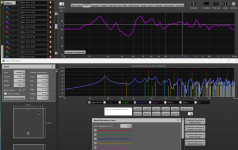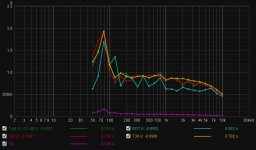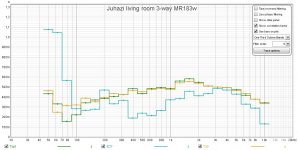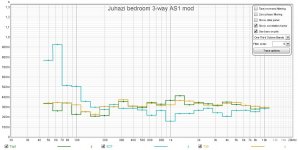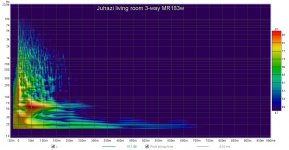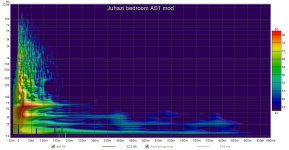In addition to wesayso's post this REW info page is good to read and the process outlined can help to see area's of the response that are not going to respond well to equalization (well at least not minimum phase equalization).
https://www.roomeqwizard.com/help/help_en-GB/html/minimumphase.html
https://www.roomeqwizard.com/help/help_en-GB/html/minimumphase.html
Thanks a lot @fluid and @wesayso 🙂
I am learning this slowly..
I played around with REW room mode simulator to see if the things I see in the MMM measurement correspond to some room-related issues. I can see a good agreement between the room-mode sim and my measurement, especially below 100 Hz. Here is a comparison plot. 🙂

The top pink plot is my right speaker's MMM (spatially averaged) response in my listening area.
The purple one below it is the room mode simulator output (based on room dimensions shown on the left hand side of the above pic). I left all the absorption coefficients as default values.
Here is the speaker's full MMM response just for reference

It seems like the axial length and width modes are aligned due to the same dimesions and causing some damage in the form of peak. The more destructive one seems to be the Tangential length/width mode causing that deep notch in the 50-60 Hz region..
Now I need to find out what to do about them (alternate placing of the speakers in some other location in the same room/another room is nota possibility for me)... 🙂
I am learning this slowly..
I played around with REW room mode simulator to see if the things I see in the MMM measurement correspond to some room-related issues. I can see a good agreement between the room-mode sim and my measurement, especially below 100 Hz. Here is a comparison plot. 🙂
The top pink plot is my right speaker's MMM (spatially averaged) response in my listening area.
The purple one below it is the room mode simulator output (based on room dimensions shown on the left hand side of the above pic). I left all the absorption coefficients as default values.
Here is the speaker's full MMM response just for reference
It seems like the axial length and width modes are aligned due to the same dimesions and causing some damage in the form of peak. The more destructive one seems to be the Tangential length/width mode causing that deep notch in the 50-60 Hz region..
Now I need to find out what to do about them (alternate placing of the speakers in some other location in the same room/another room is nota possibility for me)... 🙂
Attachments
Last edited:
There is a considerable difference between the MMM and the spectrogram, the null pattern is not the same. This isn't unusual and depends to some extent on how wide a circle you used to move the microphone.I played around with REW room mode simulator to see if the things I see in the MMM measurement correspond to some room-related issues. I can see a good agreement between the room-mode sim and my measurement, especially below 100 Hz. Here is a comparison plot. 🙂
The top pink plot is my right speaker's MMM (spatially averaged) response in my listening area.
The purple one below it is the room mode simulator output (based on room dimensions shown on the left hand side of the above pic). I left all the absorption coefficients as default values.
Here is the speaker's full MMM response just for reference
It seems like the axial length and width modes are aligned due to the same dimesions and causing some damage in the form of peak. The more destructive one seems to be the Tangential length/width mode causing that deep notch in the 50-60 Hz region..
Now I need to find out what to do about them (alternate placing of the speakers in some other location in the same room/another room is nota possibility for me)... 🙂
A test you can do yourself is to sit in the listening position and sweep REW's generator up and down in the low frequency region to see if there are any frequencies or areas that disappear or are quieter, the modal peaks should be obvious. You can do this with either speaker separately and both together. Often how the two speakers combine in frequency and phase will be different to the two individually.
The peaks can be dealt with by EQ and are not much of a concern but the nulls require a different position between speaker and boundaries as under 100Hz becomes difficult to deal with simple treatments.
In the spectrogram you can see that where there is a frequency response dip there is a time delay, the peak energy is pushed to the right. Does this actually sound like a frequency response dip? These are some of the things to consider to determine what you see in measurements and what you hear.
When you can equate a measurement to something you can hear it makes it much easier to decide what to do.
https://www.genelec.com/monitor-placement
This document from Genelec has some good pictures that should help to explain some of the trade offs in different placements.
On a general note you might want to think about making some freestanding broadband absorption panels, these would help somewhat with the reverb tank you have going on there and would also help with the difference in sound between the horns and wider radiating drivers.
They aren't expensive to make and can be taken with you if you move.
Perhaps some inspiration for mounting damping panels without hanging them. (fixed between floor and ceiling using threaded rods)
Here's another one with the panel in-between... Maybe a bit large though 😀...
Here's another one with the panel in-between... Maybe a bit large though 😀...
Thanks everyone.. 🙂
I understand that I have a lot to learn and it is fun.. 😀
I will try to get some broadband absorbers made and try to play around a little bit with the positioning of the speakers as well. Then take measurements again. 🙂
On a side note I had seen some speakers which looks really good to my eyes.. 😀
https://audiosciencereview.com/foru...es-m3-formerly-known-as-m2.14656/post-1380146
It looks like it as controlled directivity probably down to less than 100 Hz with the help of DSP.. If I make another speaker, It will probably be something like this (Dual 15/12inch + 8inch + 1inch CD horn, maybe with a better (looking/performing) horn/waveguide) 😀

I understand that I have a lot to learn and it is fun.. 😀
I will try to get some broadband absorbers made and try to play around a little bit with the positioning of the speakers as well. Then take measurements again. 🙂
On a side note I had seen some speakers which looks really good to my eyes.. 😀
https://audiosciencereview.com/foru...es-m3-formerly-known-as-m2.14656/post-1380146
It looks like it as controlled directivity probably down to less than 100 Hz with the help of DSP.. If I make another speaker, It will probably be something like this (Dual 15/12inch + 8inch + 1inch CD horn, maybe with a better (looking/performing) horn/waveguide) 😀
Last edited:
While I've put in a lot of time looking for a small footprint solution, there is a reason people say size matters and there is no replacement for displacement. If you have got room for those or something like them, I would say go for it. But think of your back also, given that you may be moving.
Think of the room too! No matter what speaker concept you end up going with...
The back-hurting part is very true... 😀 I face it very often while trying to take measurements of my current woofer module.But think of your back also, given that you may be moving.
To continue that thought experiment, if I ever make another speaker like in the above pic, it will be fully modular and stackable sort of thing interlocks or something else.
One way is by cutting the speaker in the pic into 4 modules like below:
1) Two woofer modules, each of which can be made forward-facing or one forward and one backward-facing as in the pic, depending on the directivity/complexity of implementation requirement.. 🙂
2) Midrange module
3) tweeter/horn module
All in all, a lot of flexibility in implemetation/measurements upgrading.. 🙂
I think it will be a fun project if I ever get a chance... 😀
By now, I am beginning to understand that the room is the devil as the fading channel is in the wireless industry, which is an even more complicated, dynamically changing beast. The fading channel is like our room, which causes reflections and interference to the intended signals but changes its statistics at a timescale of the order of milliseconds... 🙂 This is equivalent to the room changing its dimensions, boundary locations w.r.t the radiator and the absorption/scattering coefficients at that small a time scale, most often throwing most of the hard work done in learning and channel-combating signal adaptation that we we have done till that point down the drain.. 😀Think of the room too! No matter what speaker concept you end up going with...
But we have learnt a lot and still learn that dynamically changing beast (these days with focus more on the latest machine learning algorithms to do this job) and use smart beamforming/signal shaping techniques to combat the fading with good results..
Thinking along those lines, our rooms are more benign in what they do with the radiated waves and more deterministic in the way they screw up our signal. So, in a home environment, what we probably need to do is to learn the room and use as speaker a smartly placed array of drivers in 3D to shape the sound beam the way we want it.. The sound can also be tuned depending upon one's tastes in program material and other factors.. 🙂
In all this, I ignored the sound propagation environment shaping aspect (basically room treatment) which makes the job easy even with conventional speaker concepts.. 😀
Interesting avenues to explore all these I think.. and I am sure some people/companies are already working along similar lines as we speak.. 🙂
Maybe everyone knows about this paper, but I recently read it and found it fascinating (from a signal processing point of view).. 🙂
http://diracdocs.com/on_room_correction.pdf
To me, a lot of discussion in this paper makes real sense.. (I felt that there is a minute amount of handwaving in some parts, though) 😀
There are easily understandable explanations of what is the impact of using minimum phase filters/systems, why are the impulse response and the quantities derived from it essential, why is it that we shouldn't always get hung up on the steady-state frequency domain (only) behaviour of a system considering the inherent structure of music signals, why the time-frequency plane based analysis (Gabor, Short time Fourier transform, wavelet) makes more sense, how can reasonable correction filters be built etc etc.. 🙂
@tktran303: Now I understand why you say that Dirac live sounds good. From whatever little I know, I think it is being built by people/engineers who really know what they are doing.. 🙂
http://diracdocs.com/on_room_correction.pdf
To me, a lot of discussion in this paper makes real sense.. (I felt that there is a minute amount of handwaving in some parts, though) 😀
There are easily understandable explanations of what is the impact of using minimum phase filters/systems, why are the impulse response and the quantities derived from it essential, why is it that we shouldn't always get hung up on the steady-state frequency domain (only) behaviour of a system considering the inherent structure of music signals, why the time-frequency plane based analysis (Gabor, Short time Fourier transform, wavelet) makes more sense, how can reasonable correction filters be built etc etc.. 🙂
@tktran303: Now I understand why you say that Dirac live sounds good. From whatever little I know, I think it is being built by people/engineers who really know what they are doing.. 🙂
Anything Dirac can do, you can learn to do better if you take the time to learn the ropes.
A free tool like DRC-FIR, combined with REW has all the means needed to get great results, even able to surpass the Dirac automated process.
And it will teach you valuable lessons.
But I'd say tackle the room first...
A free tool like DRC-FIR, combined with REW has all the means needed to get great results, even able to surpass the Dirac automated process.
And it will teach you valuable lessons.
But I'd say tackle the room first...
@vineethkumar01
As mentioned I've used Dirac Live since version 1 (circa 2014-5). And so I know their website and the user interface and the software front end has been polished and looks slicker as time goes on. And so it looks Apple-esque these days, with a lot of marketing hand waving and self promotion etc.
But let's not forget that it was the fruit of Signals and System group at Uppsala Universite, the oldest university in Scandinavia, and significant R&D is done there. It was founded by professors and PhD students at the start of the 21st C based on prior work. I'm not convinced I could do better given my limited resources.
I haven't reviewed all the different methods of DRC, and would love to read a deep dive or timeline of all the products in past few decades attempting to equalise speakers in room, from a person who's not selling or promoting a product / platform / process; but it's probably challenging to do this without deep knowledge into it. I'm certainly aware that Audessy Multi EQ wasn't well favoured, and it was really Dirac Live that made things interesting again.
Maybe they are the Apple of DRC (proprietary, easy to use)... the trial software is free to download and use (for 2 channel, PC or Mac) so I think it's worth a go...
I know people may be inclined to say one can roll their own class D amplifiers as good or better than a Hypex. But you know, I've been enjoying the nCore since 2012... we don't always have to reinvent the wheel...
Now if someone can tell me there is something significantly better than Dirac Live, in 2022, even if I have to work a little harder, then I'm all ears.
As mentioned I've used Dirac Live since version 1 (circa 2014-5). And so I know their website and the user interface and the software front end has been polished and looks slicker as time goes on. And so it looks Apple-esque these days, with a lot of marketing hand waving and self promotion etc.
But let's not forget that it was the fruit of Signals and System group at Uppsala Universite, the oldest university in Scandinavia, and significant R&D is done there. It was founded by professors and PhD students at the start of the 21st C based on prior work. I'm not convinced I could do better given my limited resources.
I haven't reviewed all the different methods of DRC, and would love to read a deep dive or timeline of all the products in past few decades attempting to equalise speakers in room, from a person who's not selling or promoting a product / platform / process; but it's probably challenging to do this without deep knowledge into it. I'm certainly aware that Audessy Multi EQ wasn't well favoured, and it was really Dirac Live that made things interesting again.
Maybe they are the Apple of DRC (proprietary, easy to use)... the trial software is free to download and use (for 2 channel, PC or Mac) so I think it's worth a go...
I know people may be inclined to say one can roll their own class D amplifiers as good or better than a Hypex. But you know, I've been enjoying the nCore since 2012... we don't always have to reinvent the wheel...
Now if someone can tell me there is something significantly better than Dirac Live, in 2022, even if I have to work a little harder, then I'm all ears.
Last edited:
Yes I am hoping so.. 🙂Anything Dirac can do, you can learn to do better if you take the time to learn the ropes.
I am not saying that DIRAC's is the best possible approach. Eventually, I am going to use the combination of DRC-FIR & REW softwares only (till I get something better and if at all needed) since the learning that it gives is very valuable compared to a black box solution.. 🙂A free tool like DRC-FIR, combined with REW has all the means needed to get great results, even able to surpass the Dirac automated process.
And it will teach you valuable lessons.
At the moment, I am just doing a literature survey on the possibilities and feasibilities during which I came across the above Dirac paper. And their approach to the room "correction" process makes sense, at least from an information transfer/information theoretic/signal processing point of view. Whether it makes complete sense from a psychoacoustic point o view, I have no idea at the moment. But from the experiences of people using that software, it seems like it does. 🙂
Definitely. I am completely convinced that I have to make at least some attempts to treat the room if at all I am hoping to make the best use of the systems I have. However, since the flexibilities I have at the moment regarding room treatment are a bit limited, I hope to go with a hybrid approach with some necessary/useful room treatment and a relatively robust software-based room-induced artefact compensation filtering in a hope to at least improve the current situation with my speakers. The learning that comes from the latter part is also much more fun to me personally.. 🙂But I'd say tackle the room first...
My interest in all the impulse response-related aspects has been recently piqued by this thread over at ASR 😀
https://www.audiosciencereview.com/...f-impulse-response.38960/page-14#post-1388917
A lot of useful and practical information has been shared in that thread in the hope/interest of continuing the learning and information sharing by people, including Kimmosto and fluid. However, I feel that there is a troll in that thread who thinks that he is Richard Feynman or some such similar genius and everybody else is either an amateur or an idiot. 😀 (well, even if he is the educated scientist that he claims to be again and again, I would say his approach is very closed-minded and creates an environment which is not fertile for sharing ideas and understanding state-of-the-art and pushing it forward further). I didn't write all this there just to avoid feeding that troll. But thanks to him, people like me benefit from the resources being shared over there.. 😀
Significant and better are not so easy to quantify, but I think yes you can. Dirac's design to be easy to use and work on multiple platforms is what limit's it's capabilities. Whether you can be bothered to put the time and effort in to leverage those extra capabilities from the other platforms is only something you can answer. There is nothing wrong with picking something simple and easy.Now if someone can tell me there is something significantly better than Dirac Live, in 2022, even if I have to work a little harder, then I'm all ears.
However, I feel that there is a troll in that thread who thinks that he is Richard Feynman or some such similar genius and everybody else is either an amateur or an idiot. 😀


There is nothing wrong in what they do, but in many implementations it is limiting. The idea that one algorithm can be applied across all possible speaker types and setups without modification and achieve the best result possible for all seems an unlikely scenario to me.At the moment, I am just doing a literature survey on the possibilities and feasibilities during which I came across the above Dirac paper. And their approach to the room "correction" process makes sense, at least from an information transfer/information theoretic/signal processing point of view. Whether it makes complete sense from a psychoacoustic point o view, I have no idea at the moment. But from the experiences of people using that software, it seems like it does. 🙂
I'm glad this is being said, and I'd go a step further and say that no special tool is better than a pure acoustic solution.Anything Dirac can do, you can learn to do better if you take the time to learn the ropes.
There's no doubt that a purely acoustic solution is the best, when that is possible.
But there are many situations where that is not possible. My treadmill that is FAR right of my speakers. There's no acoustic solution that can re-position the virtual stereo image to be right in front of the treadmill, which is what I did with Dirac in matter of minutes.
Having lived in a rental properties and frequently moving, only once did I put up broadband traps and bass traps and plush carpets and thick curtains.
So to be clear I generally seek the middle path- I like keep my living room the way I'd like to live. I don't turn it into a studio, unless it is a studio... but I don't expect Diract or any DRC system so turn a toilet or bathroom to sound like a concert hall...
But there are many situations where that is not possible. My treadmill that is FAR right of my speakers. There's no acoustic solution that can re-position the virtual stereo image to be right in front of the treadmill, which is what I did with Dirac in matter of minutes.
Having lived in a rental properties and frequently moving, only once did I put up broadband traps and bass traps and plush carpets and thick curtains.
So to be clear I generally seek the middle path- I like keep my living room the way I'd like to live. I don't turn it into a studio, unless it is a studio... but I don't expect Diract or any DRC system so turn a toilet or bathroom to sound like a concert hall...
Why?I'm glad this is being said, and I'd go a step further and say that no special tool is better than a pure acoustic solution.
- Home
- Loudspeakers
- Multi-Way
- A 3 way design study
